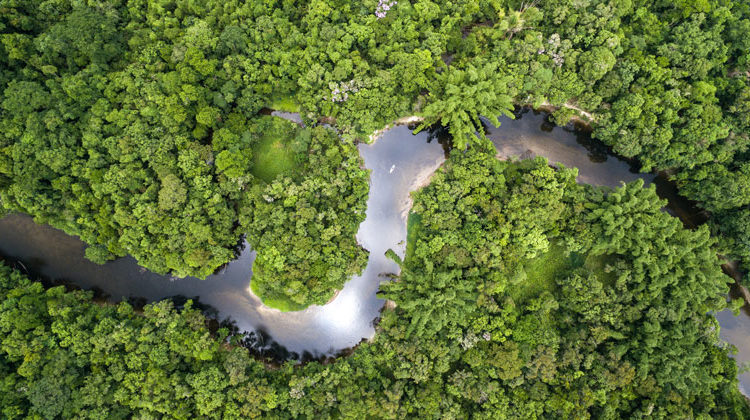
For every three trees dying from drought in the Amazon rainforest, a fourth tree – even though not directly affected – will die, too. In simplified terms, that’s what a new study published in PNAS this week shows. The research team, led by Nico Wunderling at the Potsdam Institute of Climate Action Research, used network analysis to understand the complex workings of one of Earth’s most valuable and biodiverse carbon sinks. The parts most at risk of turning into savannah are located on the forest’s southern fringes, where continuous clearing for pasture or soy has already been weakening the forest’s resilience for years.
Ripple effect
The rainforest in South America may be losing its rain and with it, its moisture supply as climate change sends more frequent and more severe drought spells to the Amazon Basin. That lack of rain threatens the forest, because it breathes water: Once rained down, the soil takes it up as much as the plants, and both release a great amount back through evaporation and transpiration. In this atmospheric moisture recycling, the forest creates much of its own weather, generating up to half of the rainfall over the Amazon Basin. And while it is highly efficient, at the end of the day the moisture recycling system relies on how much water is initially put into the system.
The research team has now found that even if a dry spell affects only one specific region of the forest, its harm stretches beyond that region by a factor of one to three. As lack of rain strongly decreases the water recycling volume, there will also be less rainfall in neighbouring regions, hence putting even more parts of the forest under significant stress.
“More intensive droughts put parts of the Amazon rainforest at risk of drying off and dying. Subsequently, due to the network effect, less forest cover leads to less water in the system overall, and hence disproportionately more harm,” Wunderling explains. “And while we’ve investigated the impact of drought, that rule also holds for deforestation. It means essentially, when you chop down one acre of forest, what you actually are destroying is 1.3 acres.”
A new climate normal
Climate science predicts that what used to be extraordinarily dry years, like 2005 and 2010, may well become the new normal from 2050 onwards, with centennial droughts occurring in up to nine out of ten years by 2060. “These recurrent droughts are already producing quantifiable changes to the Amazon’s moisture network,” explains Henrique Barbosa, co-senior author on the study and assistant professor of physics at University of Maryland, Baltimore County. “We use these observations to understand and model the consequences of a future climate that resembles a permanent drought state.”
But droughts have different effects on forest systems within the Amazon. “In the Amazon, trees and forest systems are differently adapted to water availability, as some regions commonly exhibit a distinct dry season while others have rain all year round. We specifically acknowledge these local adaptations as they can be a blessing or a curse under climate change,” adds Boris Sakschewski, a co-author of the study at the Potsdam Institute.
“So we find that even the dry season-adapted parts of the Amazon forest won’t necessarily survive a new climate normal, and the risk of tipping into savannah or no trees at all is high,” Sakschewski adds. “The consequences for biodiversity would be disastrous, but the same goes for the local, regional, and global climate.”
Still much to do
“Yet not all is lost,” says Ricarda Winkelmann, co-senior author of the study and leader of tipping elements research at the Potsdam Institute. “That is because a good part of the forest is still in relatively stable conditions. The network effects of dry spells are likely limited to certain areas in the forest’s southeast and southwest—which happen to be those areas where the forest has been suffering from the human hand already, in clearing forest for pasture or soy.”
“There is still a lot we can do to try and stabilize the Amazon, as preserving it and its ecological services is of utmost importance for local, regional and global climate stability,” Winkelmann says. “And we know how we can do that: by protecting the rainforest from logging, and by rapidly reducing greenhouse gas emissions to limit further global warming.”
